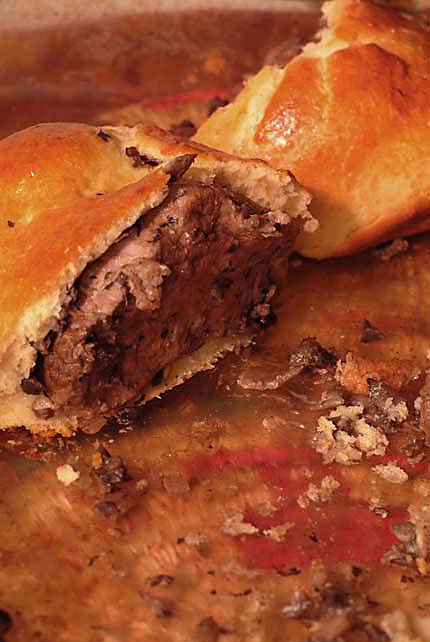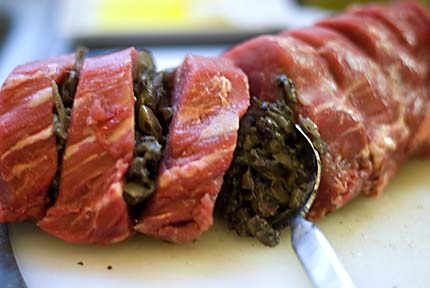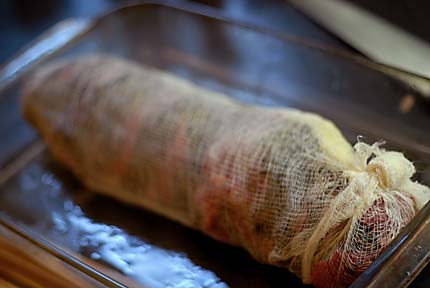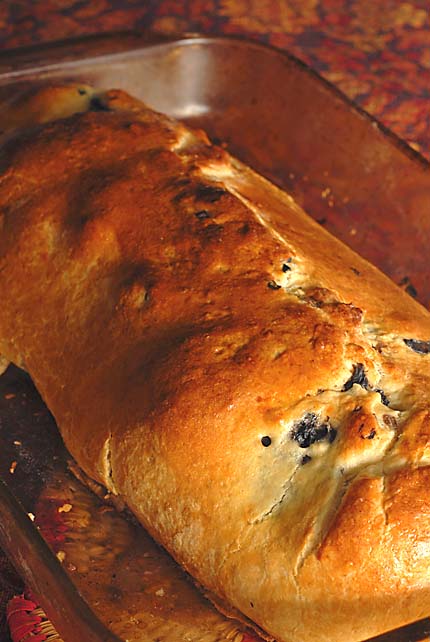Julia Child’s Beef Wellington, With Our Brioche Crust (Filet de Boeuf en Croûte)

Julia Child’s Mastering the Art of French Cooking has a terrific French bread recipe, but it takes about three days to prepare—still, it was one of the first loaves I ever was really, really happy with years ago. Back then, I wasn’t thinking about brioche, or brioche-wrapped beef tenderloin, but you can bet that I am now. The brioche recipe from Artisan Bread in Five Minutes a Day is one of the most popular ones in our book. Recently I remembered that Julia Child’s Beef Wellington recipe actually calls for brioche rather than the more traditional puff pastry (it’s in Volume Two of “Mastering the Art…”). Voilà! Easy Beef Wellington? Well, all I can tell you is that the pastry part becomes easy if you have our brioche dough in the freezer or fridge. And the result is scrumptious and festive. But five minutes a day? Well…
Julia Child’s Beef Wellington Recipe (with our brioche crust)
Defrost about 1 1/2 pounds of our brioche dough if it’s in the freezer (leave it in the fridge overnight), or use refrigerated stuff that hasn’t yest reached the five-day mark (beyond that and you run the risk of the eggs going bad). Now start prepping the beef, its stuffing, and the brown sauce Julia specified (she actually gives some choices (from Volume One!), but I just did a simplified version of her Sauce Brune.
First, finely dice carrots, onions, and celery to end up with about a third of a cup each:

Heat 6 tablespoons of butter or oil and saute the vegetables for about 10 minutes. Then add a quarter-cup of flour and continue over low heat until the mixture browns (about another 10 minutes). That super-flavorful thickening agent is known in French as a roux (pronounced “roo”):

Add 6 cups of boiling beef stock. Volume One talks about how to make your own, and I actually did an abbreviated version based on meat scraps and soup bones, but even Julia wrote that it’s not absolutely necessary. You can use canned, so she says. I kid you not.
Whisk the mixture vigorously to suspend the flour, and create a thickening sauce. Julia calls for an herb bouquet, so in theory you’re supposed to tie up 3 parsley sprigs, 1/2 a bay leaf, and 1/4 teaspoon dried thyme in cheesecloth and simmer it with your sauce, discarding it at the end.
Not going to happen around here. I minced the parsely, still from our garden in a mild Minnesota September:

The minced parsley got thrown into the simmering sauce with the half bay leave and the thyme, and the result is a chunky sauce, not the elegant smooth one that Julia was going for, especially with 3 tablespoons of minced ham (she calls for that, so she couldn’t have wanted the sauce to be that smooth). Remove the bay leaf piece at the end of cooking, but everything else stays. My version here is more home cooking than French haute cuisine (I admit it). Simmer the sauce down to about 4 cups, and add salt and pepper to taste. Don’t be stingy with the salt. Set the sauce aside and move onto the mushroom stuffing:
Create another roux with 3 tablespoons of butter (I used more), 1 pound of minced fresh mushrooms and 1/4 cup minced shallots (don’t use onions; this butter-shallot-mushroom mixture is what makes the dish). As before, saute down the vegetable before adding the flour (about 5 minutes), and then continue for a while longer (this time only a couple of minutes). Then add 1/3 cup of dry Madeira wine (I used a light-bodied inexpensive red table wine), 1 egg yolk, and 1/2 teaspoon dried tarragon. Continue cooking another few minutes, until everything has set, and set the mixture aside.
Now, onto the meat. Prepare about 2 1/2 pounds of filet mignon (aka beef tenderloin) by slicing it into 1/2-inch thick portions. Salt and pepper each piece on both sides, and re-assemble the roast with about 1 1/2 tablespoons of mushroom stuffing between each slice:

Wrestle the whole thing into a large sheet of oiled cheesecloth, roll it up, and twist the ends together so you have a tight bundle. It looks very, very weird, and if the result wasn’t so insanely delicious, I might be somewhat put off by this picture, which, take my word, is greatly helped by gauzy soft focus photography (thank you Nikon SLR technology):

Glad that’s over with. Make sure this is basted well with oil or melted butter, and bake in a roasting pan placed in the top third of the oven, pre-heated to 425 degrees F (your oven needs to be accurate here or the roasting time could be way off). I followed Julia’s directions for a 25 minute roast, but I did not baste or turn this beast. Remove from oven (it’s not done yet) and let it cool to room temperature (this is actually important in not overcooking the roast).
Preheat the oven to 425 degrees F again. Roll out a large rectangle of brioche dough to a thickness of 1/4-inch, according to Julia (though I think it might benefit from being a little thinner). The piece needs to be large enough to accept your roast, and for us that was about 1 1/2 pounds of dough (small cantaloupe-sized). I did this like a huge calzone rather than Julia’s more involved but prettier method (see our calzone post), and I sealed it on the top after pulling the dough up around it.
The tricky part is removing the cheesecloth from the cooled roast, and getting rid of it without wrecking the stuffing. I ended up slopping some of it on top of the meat, rather than between the slices. But it all got sealed up in pastry anyway (don’t slit or the juice will go everywhere):

Use a pastry brush to paint egg wash (1 egg lightly beaten with 1 tablespoon water) on the brioche dough. Do two coats, one just before baking, and one about 10 minutes into it. Lower temp to 350 when the crust has browned, and continue baking for a total of about 30 to 40 minutes. Cover with aluminum foil if it’s over browning. When done, you’ll begin to smell the meat and the stuffing and some juices will be escaping into the pan. Don’t over-do it… this was meant to be served medium rare:

Cut it up and make sure everyone a piece of steak with a good portion of the brioche, some sauce, and a glass of nice red wine. This dish was a kid crowd-pleaser (minus the wine). And there you have it, Julia Child’s Beef Wellington.
Follow us on Twitter: https://twitter.com/ArtisanBreadIn5
Oo La La!! Now I NEED to figure out how to do an eggless Brioche! What inspiration. I could eat the picture, it looks SOOO good!
The main thing about the brioche is the eggs.
Jeff,
Any idea of what the meat’s temperature should be when first removed from the oven (in the cheesecloth) and again when the whole thing is done? That would help a lot in determining cooking times.
Thanks–this looks scrumptious!
Cathie: Well, a yolkless brioche is coming in the second book– stay tuned.
Jan: Julia C. specified 125 degrees F for a rare roast, after the second baking is complete. USDA wants us eating it hotter than that, 145 at a minimum– Personally, I don’t like overcooked beef , maybe medium-rare. At USDA’s website (https://www.fsis.usda.gov/Factsheets/Beef_from_Farm_to_Table/index.asp), they call for 145 degrees F for medium rare. I’m guessing that was how mine was served, but I didn’t use my meat thermometer. My kids sometimes balk at too-rare meat, so this was probably fine, even though I might have liked it a little rarer. Jeff
what? Another great idea! I guess I’m just going have to have 3 or 4 frozen 1 1/2 # pkg of brioche in the freezer. I can hardly wait for your new book too. it’s the count down .
Bon Appetit! Julia would be so proud. That looks out of this world. 🙂
Wow! That looks fantastic and so decadent!
I hope you don’t mind me asking a quick boule related question here. I have been, I’m pretty sure, following the directions exactly for the boule in the book, but my loaves keep splitting near the bottom on the side while in the oven. What do you think I am doing wrong? They still taste great, and from the top they look beautiful.
Thanks!
Susan: You can ask a question on any subject under any Post, no problem.
Usually, odd loaf-fracturing can be solved in one of two ways:
1. A longer resting time: try 60 to90 minutes, rather than 40. See https://artisanbreadinfive.com/?p=141
2. Slash deeper: make sure you slash deeply enough so the fissure “blooms” open even before it goes into the oven.
Let me know how that works out. Jeff
Thank you, Jeff! I will bake another loaf tomorrow and will try a longer resting time and deeper slashes. I’ll let you know how it works. And thanks for that link–I will try the refrigerator rise, soon, too.
Thanks, also, for the great book and for being such a helpful resource!
Oh my word! Does that look good! I was just thinking about making Beef Wellington the other day. I was watching Chef Ramsey’s F Word show and he made one and my mouth was watering! I am thrilled to death to see this made with your Brioche dough! (Which is absolutely wonderful, BTW) I made the Brioche dough and we had Brioche with raspberry coulis and creme fraiche for dessert one night and for breakfast I made french toast with raspberry coulis and creme fraiche and my son ate it with butter and maple syrup…..they were delicious.
Last night I made the caramelized onion and herb rolls and couldn’t get over how good they were. Today I baked a boule to have with our vegetable beef soup tonight. I cannot tell you both how much I LOVE your book and your recipes. Everything I have baked has turned out fabulous and it’s so EASY! I’ve also gone through a double batch of the deli rye bread dough…OMG….Jeff, your grandmother was RIGHT….it’s better than dessert! It was sooooooo good. Corned beef sandwiches on rye. YUM! Anyway, I just had to jump in here and tell you how wonderful the Beef Wellington looks and that is next on my list to make. I just bought some filet mignon at the store today, so the timing of this recipe couldn’t be better!
Thank you both so much for your fabulous book. I just love it and haven’t had store bought bread since I got your book a month ago. I love this web site too. You two are wonderful to interact with your readers, post helpful tips and new recipes. I visit all the time, but this is my first post…the Beef Wellington sent me over the edge. 😉
Hi Vickie,
Thank you for the lovely note, we are so happy to hear from you. I have to admit I am a big fan of desserts, but I’m sooo pleased that you are enjoying the breads you bake even more! 😉
Thanks, Zoë
I know it’s a long shot, but has anyone attempted a brioche with whole wheat? Would some VWG and soft white wheat do the trick?
Mickelle: We do brioche with whole wheat in the upcoming book, which is now only 24 days from release: Click here to pre-order on Amazon https://tinyurl.com/pe8yr9
Jeff
I also have a boule question. My last loaf’s worth of dough from the tub is always really wet. I get a good tasting, but flat loaf. Any suggestions?
Hi Stephanie,
About how old is the dough? If you are seeing a brownish liquid on top of the dough, you can just pour it off, it is a natural byproduct of the dough and actually acts as a preservative for the dough. Totally normal. However, if you mean that the dough itself is very wet and kind of mushy, this sometimes happens if the dough has sat in the bucket for several days without being touched at all. You can just incorporate more flour to the batch, then you need to let it rest for about an hour before using it. The other option is to mix a fresh batch of dough right on top of this dough. Doing this will give new life to the old dough and jump start the flavor of the new batch.
As you said the dough will lose some of its rising power towards the end of the recommended storage time, so you may want to use it for flatbreads and not high domed boules. You can also try baking it in a loaf pan.
I hope this helps. Thanks, Zoë
I baked another boule yesterday and went with a 90 minute resting time (it was also a slightly larger than one pound loaf) and deeper slashes. It turned out much better. Thanks for the advice!
Hi Susan,
So glad that you had success! 🙂
Thanks, Zoë
I tried the “Master Recipe” but found the bread to be overly salty, but, otherwise quite good. Recipe states: 1-1/2 tablespoons of salt – can it be reduced and still work?
Hi Ann,
You can reduce or even eliminate the salt in the dough. It should suit your palate and will not adversely effect the dough by doing so. Here is a post about salt in the bread: https://artisanbreadinfive.com/?p=139
Thanks and enjoy! Zoë
Hello, Ann Evangelista,
I only use 1 T Kosher salt for the Master Recipe and have been very happy with the results, except for the last loaf being real wet, even the Olive Oil dough as I learned when making the delish Onion-Rosemary Focicca
Zoe,
Thanks for the suggestions for my mushy dough. The mushy dough is usually over a week old. Will try incorporating more flour towards the end of the two weeks. Have a ‘new’ batch in the oven right now and it smells fabulous.
Really loved the focicca! It nicely complemented linguini and red clam sauce last night.
Hi Stephanie,
Keep us posted and let us know if this fixes the issue! Enjoy all the bread!
Zoë
Thanks Zoe & Stephanie. I’m going to give this another try! Can’t wait!!!
I’ve always wanted to make a Beef Wellington and, thankfully, we have some fresh venison in the freezer so we’ll try it with venison tenderloin. It should be terrific since the meat is so lean and can become dry otherwise. I also like the mushroom filling instead of duck/goose pate. Thanks for a great-looking recipe.
Hi Linda,
Do let us know how it turns out, I bet the venison is going to be amazing!
Enjoy, Zoë
Above you said to incorporate more flour into older dough and let it rise longer. Do you mean to actually mix it in, or let it sit on top of the prepared dough?
Thanks.
Hi Nina,
If you are mixing more flour into a dough that is already prepared you will need to let it rest again. It is when you are incorporating the flour, not just letting it sit atop the old dough.
Hope that clears it up for you! Zoë
My breads, while they have a good crumb, still do not rise well. Can I add some Vital Gluten Flour (per the Healthy Bread in Five book) to the standard recipes to give me a bit more lift? I halve, but follow the ingredients diligently, specifically the European Peasant from the Artisan book and my loaves are seldom higher than 2 1/2″ when baked.
Hi Karl,
What brand of flour are you using now? You can either add vital wheat gluten, or try using bread flour. But, you will need to increase the water to make up for the additional protein in the flour.
How long are you letting the loaf rest before baking?
Thanks, Zoë
Thank you for posting this, it was awesome! (We had to buy the book too, which was no hardship and great for all sorts of things). I have made this recipe twice now and each time it has been excellent. It’s a little finickity and the tenderloin is not cheap, but I would say this recipe is fabulous and well worth the trouble…. good grief I am starting to salivate just thinking about it! JUST DO IT!
Hi Chris,
Thank you for the wonderful note, so glad you are enjoying the recipe and book!
Cheers, Zoë
How many servings do you get from this?